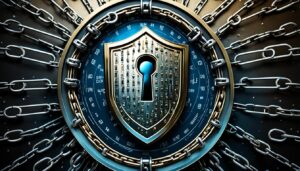The SP800-37 Framework is an essential resource for organizations seeking to effectively manage and reduce cybersecurity risk. It provides a comprehensive set of standards, guidelines, and practices that can be customized to fit the unique needs and risks of small and medium-sized enterprises (SMEs). While the framework is voluntary, it has become mandatory for certain organizations, including U.S. federal government agencies. As experts in cybersecurity, we understand the importance of simplifying the SP800-37 Framework for SMEs, so they can easily navigate and implement effective cybersecurity measures. In this guide, we will break down the framework, explain its components, and provide actionable insights on how SMEs can start using it to enhance their cybersecurity posture.
Key insights for SMEs from the SP800-37 Framework:
- The SP800-37 Framework is designed to help organizations manage and reduce cybersecurity risk.
- It provides a set of standards, guidelines, and practices that can be customized to suit an organization’s unique risks and needs.
- The Framework is voluntary but has been made mandatory for certain organizations, such as U.S. federal government agencies.
- The NIST Framework website offers resources to help organizations implement the Framework, including a Quick Start Guide and a Resource Repository.
Benefits of the SP800-37 Framework for SMEs:
- Assists in raising awareness about cybersecurity risks and best practices.
- Fosters communication and collaboration among internal and external stakeholders.
- Customizable to fit SMEs’ specific risks and business requirements.
- Enhances overall cybersecurity posture and helps prioritize security efforts.
- A strategic planning tool for risk assessment and compliance with legislation and regulation.
Getting started with the SP800-37 Framework:
- Visit the NIST Framework website for valuable resources, including a Quick Start Guide and Resource Repository.
- Customize the Framework to fit your SME’s unique risks, situations, and needs.
- Allocate dedicated resources for implementing and managing the Framework, including trained personnel and sufficient budget.
- Obtain commitment from top management to prioritize cybersecurity and allocate necessary resources.
- Regularly monitor and evaluate the effectiveness of the Framework for continuous improvement.
What is the SP800-37 Framework and how does it work?
The SP800-37 Framework is a comprehensive cybersecurity risk management framework that organizations can use to effectively manage and mitigate cybersecurity risks. It is based on existing standards, guidelines, and practices, providing a set of flexible and customizable processes. The framework is designed to foster communication and collaboration among internal and external stakeholders, enabling a holistic approach to cybersecurity.
Unlike a checklist-based approach, the SP800-37 Framework outlines desired outcomes to address cybersecurity risks. It encourages organizations to assess their unique risks and tailor the framework to their specific needs. By doing so, organizations can establish a solid foundation for effective cybersecurity risk management.
Framework Core
The Framework Core is the central component of the SP800-37 Framework. It consists of a set of cybersecurity activities, outcomes, and references that are common across critical infrastructure sectors. These activities and outcomes are designed to help organizations identify, protect, detect, respond to, and recover from cybersecurity incidents.
Framework Implementation Tiers
Framework Implementation Tiers provide context on how an organization manages and mitigates cybersecurity risks. These tiers range from Partial (Tier 1) to Adaptive (Tier 4) and reflect the organization’s level of cybersecurity risk management maturity. The tiers assess the extent to which cybersecurity risks are managed in alignment with organizational goals and objectives.
Framework Profiles
Framework Profiles represent the desired cybersecurity outcomes for an organization based on its business needs and risk assessments. Organizations can prioritize their security efforts and allocate resources effectively by aligning their profiles with industry best practices and regulatory requirements. Framework Profiles help organizations focus their cybersecurity efforts on achieving their specific goals.
The NIST Cybersecurity Framework provides direction and guidance for organizations seeking to improve their cybersecurity risk management. It complements the SP800-37 Framework by offering a structured approach to identifying, protecting, detecting, responding to, and recovering from cybersecurity incidents. By combining the SP800-37 Framework and the NIST Cybersecurity Framework, organizations can establish robust cybersecurity risk management practices to safeguard their critical assets and information.
How to get started with the SP800-37 Framework?
Implementing the SP800-37 Framework is a crucial step towards managing cybersecurity risk effectively. To get started, organizations can leverage the resources available on the NIST Framework website. This website serves as a comprehensive hub of knowledge and guidance for organizations embarking on their cybersecurity journey.
The first resource organizations should explore is the Quick Start Guide provided on the NIST Framework website. This guide offers clear direction and practical steps for implementing the SP800-37 Framework. It serves as a valuable starting point for organizations, providing an overview of the key components and guidelines for customizing the Framework to their specific needs.
Another valuable resource available on the NIST Framework website is the Resource Repository. This repository is a treasure trove of approaches, methodologies, implementation guides, case studies, and other helpful materials that can assist organizations in customizing the SP800-37 Framework to best suit their risks, situations, and needs.
Available Resources on the NIST Framework Website
| Resource | Description |
|---|---|
| Quick Start Guide | A comprehensive guide that provides direction and guidance for implementing the SP800-37 Framework. |
| Resource Repository | Offers a wide range of materials including approaches, methodologies, implementation guides, case studies, and more. |
By utilizing these resources from the NIST Framework website, organizations can establish a solid foundation for implementing the SP800-37 Framework and effectively managing their cybersecurity risks. These resources not only provide guidance but also empower organizations to customize the Framework to align with their specific requirements, ensuring a comprehensive and tailored approach.
Who needs to use the SP800-37 Framework?
While the SP800-37 Framework is voluntary, there are specific organizations that are required to implement it. The mandatory implementation of the framework is evident in various sectors, including the U.S. federal government and insurance organizations.
In the case of U.S. federal government agencies, the implementation of the SP800-37 Framework is mandated by Executive Order 13800. This order establishes the requirement for government agencies to adopt the framework in order to effectively manage and mitigate cybersecurity risks.
Insurance organizations also recognize the importance of the SP800-37 Framework in enhancing cybersecurity practices. As a result, they have made the framework mandatory, ensuring that organizations within the insurance industry adhere to the framework’s guidelines and standards.
Additionally, certain federal, state, and foreign governments have also made the implementation of the SP800-37 Framework mandatory for specific sectors or purposes. This further underscores the significance of the framework in promoting robust cybersecurity practices and risk management.
Moreover, some organizations may require the usage of the SP800-37 Framework for their customers or within their supply chain. By mandating the framework’s implementation, these organizations ensure that their operations align with industry best practices and meet the cybersecurity expectations of their stakeholders.
In summary, while voluntary in nature, the SP800-37 Framework is mandatory for U.S. federal government agencies and insurance organizations, as well as for specific sectors or purposes in certain federal, state, and foreign governments. Its implementation is crucial in strengthening cybersecurity practices and in meeting the industry’s evolving security requirements.
How is the SP800-37 Framework used by organizations?
Organizations are leveraging the SP800-37 Framework in multiple ways to enhance their cybersecurity practices and mitigate risk. This comprehensive framework serves as a valuable tool for raising awareness, facilitating communication, and aligning cybersecurity expectations across various stakeholders.
Raising Awareness and Facilitating Communication
The SP800-37 Framework plays a crucial role in raising awareness about cybersecurity within organizations. It provides a common language and framework for discussing cybersecurity risks, vulnerabilities, and countermeasures. By using the framework, organizations can effectively communicate the importance of cybersecurity to all members, including executive leadership, employees, and contractors.
With the SP800-37 Framework, organizations can foster a culture of cybersecurity awareness, ensuring that all individuals within the organization understand their roles and responsibilities in safeguarding sensitive information and protecting critical assets. This framework lays the foundation for open communication channels, collaborative decision-making, and the exchange of best practices among stakeholders.
Communication Across Organizations
Another key benefit of the SP800-37 Framework is its ability to facilitate communication across organizations. By adopting the framework, businesses can effectively communicate their cybersecurity expectations to business partners, suppliers, and vendors. This ensures that cybersecurity requirements are clearly understood and integrated into collaborative efforts.
The framework serves as a common reference point for organizations to share cybersecurity expectations, standards, and guidelines. This promotes consistency and alignment of cybersecurity practices across different sectors, enhancing the overall security posture of the ecosystem.
Mapping to Current Cybersecurity Management Approaches
Organizations are also leveraging the SP800-37 Framework to improve their current cybersecurity management approaches. By mapping their existing practices to the framework’s core components and outcomes, organizations can identify gaps in their cybersecurity posture and develop targeted strategies to address those gaps effectively.
This mapping exercise allows organizations to align their cybersecurity practices with the best practices outlined in the framework. It provides a structured approach to identify vulnerabilities, assess risks, and prioritize mitigation efforts. By integrating the SP800-37 Framework into their cybersecurity management, organizations can enhance their resilience against evolving cyber threats.
Strategic Planning and Policy Alignment
The SP800-37 Framework serves as a strategic planning tool for organizations, enabling them to conduct thorough risk assessments and align their policies with relevant legislation and regulations. By following the framework, organizations can ensure that their cybersecurity programs are in compliance with industry standards and legal requirements.
This strategic planning component of the framework helps organizations prioritize cybersecurity investments, allocate resources effectively, and establish robust cybersecurity governance structures. It enables organizations to stay ahead of emerging threats and adapt their cybersecurity strategies accordingly.
Benefits of Using the SP800-37 Framework
| Benefits | Description |
|---|---|
| Raising Awareness | Facilitates a culture of cybersecurity awareness within organizations. |
| Communication | Enhances communication of cybersecurity expectations across organizations and sectors. |
| Mapping to Current Practices | Identifies gaps in cybersecurity management and guides targeted improvements. |
| Strategic Planning | Enables strategic planning, risk assessment, and policy alignment. |
The SP800-37 Framework empowers organizations to elevate their cybersecurity awareness, foster effective communication, and align their practices with industry standards. By leveraging this comprehensive framework, organizations can strengthen their cybersecurity posture, mitigate risks, and navigate the increasingly complex cybersecurity landscape.
What are the components of the SP800-37 Framework?

The SP800-37 Framework consists of several key components that organizations can leverage to strengthen their cybersecurity risk management efforts.
Framework Core:
The Framework Core forms the foundation of the SP800-37 Framework. It encompasses a comprehensive set of cybersecurity activities, outcomes, and references that are applicable across various critical infrastructure sectors. By focusing on the Framework Core, organizations gain a strategic view of their cybersecurity risk management, enabling them to develop robust and effective risk mitigation strategies.
Framework Profiles:
Framework Profiles allow organizations to tailor the SP800-37 Framework to their specific business needs. By defining the cybersecurity outcomes that align with their unique requirements, organizations can prioritize their efforts and effectively address their most critical risks. The Framework Profiles ensure that the implementation of the SP800-37 Framework is customized and aligned with organizational objectives, maximizing its impact.
Framework Implementation Tiers:
Framework Implementation Tiers provide organizations with context on how they manage and mitigate cybersecurity risks. These tiers categorize organizations based on their current cybersecurity risk management practices, ranging from Tier 1 (Partial) to Tier 4 (Adaptive). By mapping their current capabilities to the Framework Implementation Tiers, organizations gain insights into their progress and can identify areas for improvement.
These three components work in tandem, enabling organizations to achieve a comprehensive and tailored approach to their cybersecurity risk management. The Framework Core provides the overarching framework, while the Framework Profiles and Framework Implementation Tiers allow organizations to customize and gauge their efforts effectively.
How does an IT risk-management framework enhance security standards for SMEs?
IT risk-management frameworks play a crucial role in enhancing security standards for small and medium-sized enterprises (SMEs). One such framework is the SP800-37 Framework, which provides SMEs with a structured approach to identifying, assessing, addressing, and monitoring cybersecurity risks.
By implementing an IT risk-management framework, SMEs can prioritize their security efforts and establish clear security standards. This ensures that all security measures align with industry best practices and regulatory requirements. The framework helps SMEs communicate their security expectations effectively with their stakeholders, such as employees, customers, and business partners.
The IT risk-management framework, like the SP800-37 Framework, provides guidance on implementing security controls that protect SMEs from potential threats. These controls can include measures such as access controls, encryption, incident response plans, and employee awareness training. With the framework’s help, SMEs can effectively manage security incidents and minimize the potential impact on their operations.
Implementing an IT risk-management framework also enables SMEs to improve their overall security posture. By following a structured approach, SMEs can identify vulnerabilities, assess the potential risks, and implement appropriate controls to mitigate those risks. This proactive approach helps SMEs protect their valuable information assets from unauthorized access, data breaches, and other cybersecurity threats.
In summary, an IT risk-management framework, such as the SP800-37 Framework, enhances security standards for SMEs by providing a structured approach to managing cybersecurity risks. It helps SMEs prioritize security efforts, establish clear standards, and communicate expectations. By implementing security controls and following best practices, SMEs can improve their overall security posture and protect their valuable information assets.
| Benefits of IT Risk-Management Framework for SMEs | Explanation |
|---|---|
| Structured Approach | Provides SMEs a systematic process for identifying, assessing, addressing, and monitoring cybersecurity risks. |
| Clear Security Standards | Enables SMEs to establish industry-recognized security standards to ensure compliance and alignment with best practices. |
| Effective Communication | Facilitates the communication of security expectations with stakeholders such as employees, customers, and business partners. |
| Implementing Security Controls | Provides guidance on implementing security controls to protect SMEs from threats and vulnerabilities. |
| Managing Security Incidents | Helps SMEs develop incident response plans and procedures to effectively manage security incidents. |
| Improved Security Posture | Enables SMEs to identify vulnerabilities, assess risks, and implement appropriate controls to protect information assets. |
What is necessary to establish an effective IT risk-management framework in SMEs?
To establish an effective IT risk-management framework in SMEs, several factors are necessary. It is crucial for SMEs to understand their unique risks and tailor the framework to suit their specific needs. This customization ensures that the framework aligns with the organization’s risk profile and business requirements.
SMEs should allocate dedicated resources to implement and manage the framework. This includes having trained personnel who can effectively execute the risk-management processes and make informed decisions. Additionally, SMEs need to allocate a sufficient budget to support the implementation and maintenance of the framework.
A strong commitment from top management is essential for effective implementation. It is crucial for senior leaders to prioritize cybersecurity and allocate the necessary resources for its implementation. This commitment sets the tone for the organization and reinforces the importance of cybersecurity as a strategic priority.
Regular monitoring and evaluation of the framework’s effectiveness are crucial for continuous improvement. This ensures that any gaps or areas of improvement are identified and addressed promptly. It also allows for the framework to be updated and adapted as the organization’s risk landscape evolves.
An IT risk-management framework that is effectively implemented and customized to an SME’s needs can significantly enhance cybersecurity measures and mitigate potential risks. By investing in the right resources and fostering a culture of security, SMEs can protect their valuable information assets and maintain a strong defense against cyber threats.
How are emerging IT risk-management frameworks addressing the shortcomings of established standards for SMEs?

Emerging IT risk-management frameworks are revolutionizing the way SMEs approach cybersecurity by addressing the shortcomings of established standards. These frameworks recognize the unique challenges faced by SMEs, such as limited resources and specific risk profiles. They provide simplified and customizable approaches to risk management, enabling SMEs to implement effective security measures without incurring excessive costs.
Unlike traditional standards, emerging frameworks focus on practicality and tailoring solutions to meet the specific cybersecurity needs of SMEs. By bridging the gap between established standards and the realities of SMEs, these frameworks offer adaptable and cost-effective solutions that empower small and medium-sized enterprises to enhance their security posture.
One of the primary shortcomings of established standards for SMEs is their complexity and rigidity, which can be difficult for resource-constrained organizations to navigate and implement effectively. Emerging frameworks, on the other hand, emphasize simplicity and flexibility, enabling SMEs to prioritize and operationalize cybersecurity measures that align with their unique risk landscape.
Another significant challenge SMEs face is the affordability of cybersecurity solutions. Established standards often require significant financial investments, making them impractical for SMEs with limited budgets. Emerging frameworks, however, offer cost-effective alternatives that leverage innovative approaches to risk management. These frameworks provide SMEs with the necessary guidance and tools to implement robust security measures within their budgetary constraints.
Furthermore, emerging frameworks address the issue of limited expertise and resources within SMEs. Unlike established standards that assume a comprehensive understanding of cybersecurity principles, emerging frameworks provide SMEs with simplified guidance and resources that require minimal cybersecurity knowledge. This approach enables SMEs to effectively manage their cybersecurity risks without the need for extensive technical expertise or dedicated cybersecurity teams.
To illustrate the benefits of emerging IT risk-management frameworks for SMEs, consider the following comparison:
| Established Standards | Emerging Frameworks |
|---|---|
| Complex and rigid | Simplified and flexible |
| Expensive and resource-intensive | Cost-effective and adaptable |
| Require extensive expertise | Accessible to non-technical users |
As SMEs continue to face evolving cybersecurity threats, emerging IT risk-management frameworks offer a lifeline by providing practical, tailored, and cost-effective solutions that address their unique needs. By empowering SMEs with simplified risk-management approaches, these frameworks contribute to the overall cybersecurity resilience of the SME sector, ensuring their continued growth and success in an increasingly digital world.
The effectiveness of established IT risk-management frameworks
A systematic literature review reveals the effectiveness of established IT risk-management frameworks. Previous studies have examined various frameworks in different contexts, including cloud computing, ISO/IEC 27001, and SMEs. These studies evaluate the strengths and weaknesses of the frameworks, identify gaps and limitations, and provide recommendations for improvement. The findings of these studies contribute to enhancing the effectiveness of IT risk-management frameworks for organizations operating in diverse contexts, including SMEs.
Evaluation of IT Risk-Management Frameworks in Different Contexts
Through a systematic literature review, researchers have evaluated the effectiveness of established IT risk-management frameworks across different contexts, such as cloud computing, ISO/IEC 27001, and SMEs. These studies have provided valuable insights into the strengths and weaknesses of these frameworks, enabling organizations to better understand their suitability and effectiveness in specific scenarios. By examining the performance of IT risk-management frameworks in various contexts, organizations can make informed decisions about their implementation and customization to ensure optimal risk management.
Gaps and Limitations Identified
As a result of the systematic literature review, researchers have identified certain gaps and limitations within established IT risk-management frameworks. These shortcomings include areas where frameworks may not adequately address emerging threats or fail to provide clear guidelines for specific industry sectors. The review also highlights potential challenges in customizing frameworks to the unique needs of organizations, especially small and medium-sized enterprises (SMEs). By identifying these gaps and limitations, organizations can focus on refining existing frameworks and developing new approaches to enhance their effectiveness.
Recommendations for Improvement
The systematic literature review has generated valuable recommendations for improving the effectiveness of IT risk-management frameworks. These recommendations aim to address the identified gaps and limitations, offering practical solutions for organizations seeking to enhance their cybersecurity risk management. Recommendations may include the development of industry-specific guidelines, the integration of emerging technologies into frameworks, or the implementation of more robust measurement and evaluation mechanisms. By implementing these recommendations, organizations can strengthen their risk-management practices and improve their overall cybersecurity posture.
| Framework | Strengths | Weaknesses |
|---|---|---|
| SP800-37 Framework | – Provides a comprehensive approach to cybersecurity risk management – Offers flexibility for customization – Aligns with industry best practices |
– May require additional resources to implement effectively – Can be complex, especially for SMEs |
| ISO/IEC 27001 | – Internationally recognized standard – Provides a systematic approach to information security management – Offers a framework for continual improvement |
– Can be time-consuming to implement – Requires ongoing maintenance and compliance efforts |
| NIST Cybersecurity Framework | – Helps organizations prioritize and manage cybersecurity risks – Enhances transparency and communication – Facilitates collaboration among stakeholders |
– May not address industry-specific requirements – Can be challenging to implement for certain organizations |
Recommendations for future research and development
Based on the systematic review of the literature, we can make several recommendations for future research and development of IT risk-management frameworks. These recommendations aim to address the gaps and limitations identified in existing frameworks, improve customization options for different organizations and contexts, enhance cost-effectiveness, and promote continuous monitoring and evaluation.
Firstly, further research should focus on developing frameworks that provide more flexibility and adaptability to meet the diverse needs of organizations. Customization options should be expanded to allow organizations to tailor the frameworks to their specific risk profiles and operating environments.
Secondly, there is a need to enhance the cost-effectiveness of IT risk-management frameworks, especially for small and medium-sized enterprises (SMEs) with limited resources. Future research should explore strategies to minimize implementation costs while maximizing the security benefits of the frameworks.
Lastly, the integration of emerging technologies, such as artificial intelligence (AI) and machine learning, into IT risk-management frameworks should be a priority for future development. These technologies have the potential to enhance cybersecurity practices by automating risk assessment, threat detection, and incident response.







